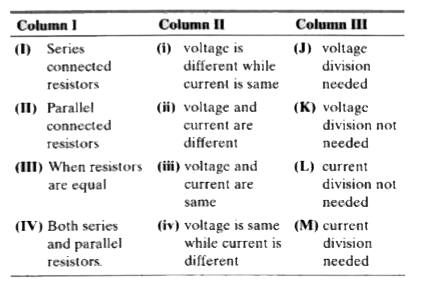Electric current is the flow of particles with
a negative charge
a positive charge
both positive and negative charges flowing opposite to each other
neutral charge
The correct Answer is:C
Topper's Solved these Questions
- CHEMICAL EFFECTS OF ELECTRIC CURRENT BOOK - MTG IIT JEE FOUNDATIONCHAPTER - CHEMICAL EFFECTS OF ELECTRIC CURRENT EXERCISE - EXERCISE (MATCH THE FOLLOWING)
3 Videos
- CHEMICAL EFFECTS OF ELECTRIC CURRENT BOOK - MTG IIT JEE FOUNDATIONCHAPTER - CHEMICAL EFFECTS OF ELECTRIC CURRENT EXERCISE - EXERCISE (ASSERTION & REASON TYPE )
10 Videos
- CHEMICAL EFFECTS OF ELECTRIC CURRENT BOOK - MTG IIT JEE FOUNDATIONCHAPTER - CHEMICAL EFFECTS OF ELECTRIC CURRENT EXERCISE - EXERCISE (MULTIPLE CHOICE QUESTIONS) (LEVEL - 1)
30 Videos
- FOOTSTEPS TOWARDS JEE MAINBOOK - MTG IIT JEE FOUNDATIONCHAPTER - FOOTSTEPS TOWARDS JEE MAINEXERCISE - SECTION B (NUMERICAL VALUE TYPE QUESTIONS)
10 Videos
Similar Questions
Electrical current is the flow of charged particles. The electric current flows through a wire the same way as how water moves in a river. The electricity is nothing but the flow of electrons.

What does the graph signify?
View SolutionHow can we say that electric current is due to flow of charge?
View Solution
Knowledge Check
Electric current flows
Afrom lower to higher potentialBfrom higher potential to lower potentialCdepends on the materialDin all directionsElectrical current is the flow of charged particles. The electric current flows through a wire the same way as how water moves in a river. The electricity is nothing but the flow of electrons.

What does the graph signify? A(II) (iv) (J)B(IV) (i) (M)C(I) (ii) (L)D(III) (iv) (K)
A(II) (iv) (J)B(IV) (i) (M)C(I) (ii) (L)D(III) (iv) (K)Electrical current is the flow of charged particles. The electric current flows through a wire the same way as how water moves in a river. The electricity is nothing but the flow of electrons.

What does the circuit diagram signify? A(III) (i) (K)B(IV) (i) (J)C(III) (iii) (M)D(III) (ii) (M)
A(III) (i) (K)B(IV) (i) (J)C(III) (iii) (M)D(III) (ii) (M)
Electrical current is the flow of charged particles. The electric current flows through a wire the same way as how water moves in a river. The electricity is nothing but the flow of electrons. There are two main combinations of resistors in circuit, that is series and parallel. In the given table, Column I shows different combinations of resistors, Column II shows voltages of different arrangements of resistors and Column III shows currents and voltage division needed or not in different arrangements of resistors.

When does the current division problem arise?
View SolutionElectrical current is the flow of charged particles. The electric current flows through a wire the same way as how water moves in a river. The electricity is nothing but the flow of electrons. There are two main combinations of resistors in circuit, that is series and parallel. In the given table, Column I shows different combinations of resistors, Column II shows voltages of different arrangements of resistors and Column III shows currents and voltage division needed or not in different arrangements of resistors.

When there is no voltage division problem arise?
View SolutionElectrical current is the flow of charged particles. The electric current flows through a wire the same way as how water moves in a river. The electricity is nothing but the flow of electrons. There are two main combinations of resistors in circuit, that is series and parallel. In the given table, Column I shows different combinations of resistors, Column II shows voltages of different arrangements of resistors and Column III shows currents and voltage division needed or not in different arrangements of resistors.

When does the voltage division problem arise?
View SolutionElectric current can flow through
View SolutionWhat causes an electric current to flow in a circuit ?
View Solution
